Poinsettia care can be tricky, but they aren’t difficult to grow once you know what they need. In this post I’ll tell you all you need to know in order to keep them alive after Christmas, and for many years to come.

Poinsettias are bright and beautiful symbols of the holiday season. Their mere presence in a room transforms the space into a more festive and merry place.
Though they are commonly sold as gift plants, you can keep them growing year-round. They are fairly easy to keep alive, and can last for many years.
In this detailed care guide, I will show you everything you need to know about how to grow poinsettia plants through Christmas, and beyond.
You’ll get tons of information about them, and learn everything from watering to light, humidity, soil, repotting, fertilizing, and much more!
Poinsettias Plant Care Overview
| Scientific name: | Euphorbia pulcherrima |
| Classification: | Tropical plant |
| Common names: | Poinsettia, Christmas Star |
| Hardiness: | Zones 10+ |
| Temperature: | 60-80°F |
| Flowers: | Yellow blooms in winter, bract colors varies by variety |
| Light: | Full sun to partial shade |
| Water: | Allow soil to dry between waterings, do not overwater |
| Humidity: | High to average humidity |
| Fertilizer: | General purpose plant food spring through fall |
| Soil: | Fast-draining soil |
| Common pests: | Spider mites, whiteflies |
Information About Poinsettias
The poinsettia (Euphorbia pulcherrima) is a member of the latex family. They’re native to Mexico and Guatemala, where they can become as tall as 10′.
They grow wildly in the ideal climate, and many people even consider them weeds.
Their ease of care and maintenance contribute to their popularity. Well, that and the fact that they’re a symbol of the Christmas season, and an iconic part of our holiday culture.
Different Types Of Poinsettias
There are hundreds of different types of poinsettias that you can grow these days. Traditionally they are red, and that remains the most popular color on the market.
But you can also find cultivars in pink, salmon, white, mottled, and even blue or purple, if that suits your fancy.
The sizes of each variety vary considerably as well. During the holiday season, you can find small ones that grow no more than 3-4″ tall. While larger ones can be several feet tall.
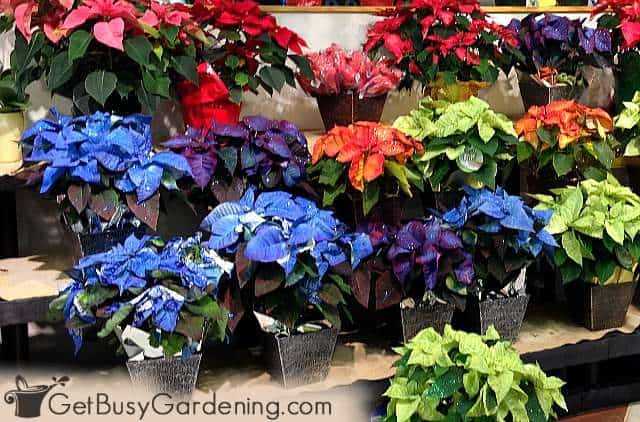
Poinsettia Flowers
The normal bloom time for poinsettias is December through January, just in time for the holidays. But the flowers probably aren’t what you think.
The red, white, pink, and mottled colors of the leaves are commonly confused for the blooms.
However, the flowers are actually the small yellow unassuming structures in the center of the colorful foliage.
The showy part of the plant surrounding these inconspicuous blooms are technically called bracts, not flowers.
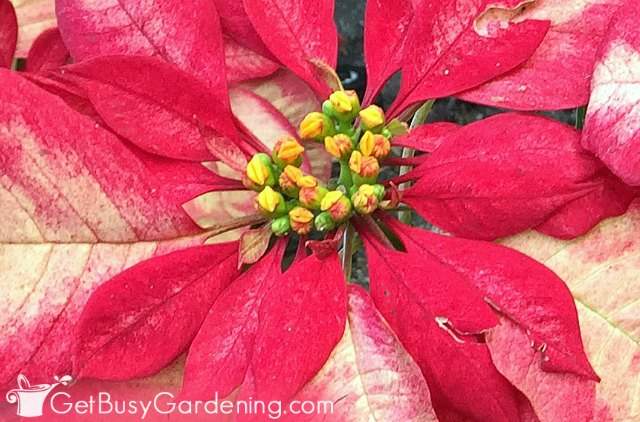
Poinsettia Toxicity
It is a common misconception that poinsettias are highly toxic, however studies have shown that they aren’t nearly as dangerous as many people think.
The sap can be a skin irritant and cause minor symptoms if ingested. So you may want to be careful while pruning, and keep them out of reach of pets that like to chew on plants.
How To Grow Poinsettias
Before we dive into the detailed poinsettia care instructions, it’s important to understand a few key things about where to grow them in order to be as successful as possible.
Hardiness
Even though they are grown mainly as holiday gift plants, poinsettias are actually tender perennials that are hardy in zones 10 or higher.
The fact that they are the official flower of Christmas is very ironic because they have no tolerance to the cold.
So, unless you live in an area where it never freezes, then you will need to bring yours indoors during the winter.
Related Post: How To Care For A Christmas Cactus
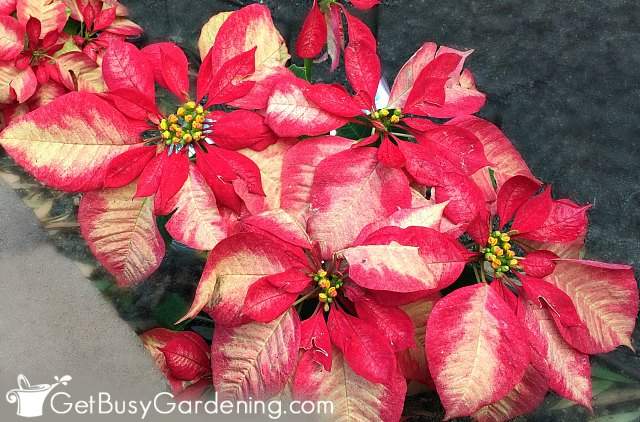
Where To Grow Poinsettias
If you live in a warm enough climate, you can grow your poinsettia outdoors year round.
An ideal spot would be somewhere they will get morning and/or evening sun, but are protected from the hot afternoon rays.
For the rest of us, they do better as houseplants. They need bright, indirect light away from any heating vents or cold drafts.
Though they can grow indoors all year round, they will benefit from being outside during the summer. If you want to move yours out, wait until it is consistently above 60°F in the spring.
Learn everything you need to know about how to grow them outdoors here.
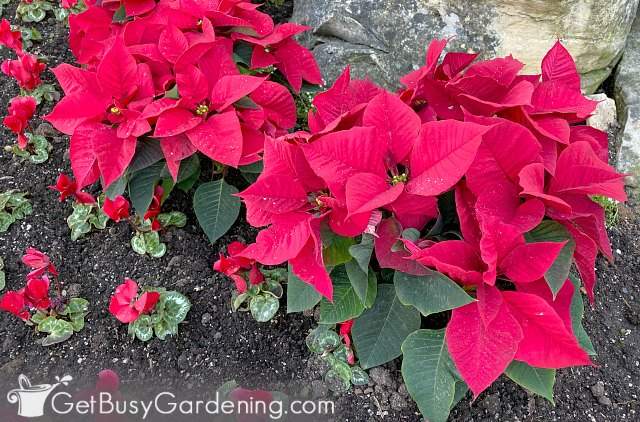
Poinsettia Plant Care & Growing Requirements
Despite the differences in appearance, all varieties of poinsettias have the same basic care needs. That is great news, since it makes growing them much easier.
Watering
Probably the biggest mistake people make with poinsettia care (and the most common cause of their death) is overwatering. They do not like a lot of it.
They need consistent moisture, but their roots cannot tolerate being saturated. So, it is very important to always check to make sure they need it before adding more.
Ideally, you should let them dry out in between, but never to the point where the plant starts to wilt.
Be sure to let any excess drain completely from the pot, and never leave it soaking. If you struggle with getting it right, I recommend you buy an inexpensive moisture gauge to help you out.
Otherwise, you can learn all of the details about how and when to water them here.
Humidity
Though they don’t like a lot of water, they do love high humidity, and hate when the air gets too dry.
Since it’s pretty dry inside of a standard home in the wintertime, make sure you provide extra humidity.
Place it on a pebble tray, or run a humidifier next to it. I don’t recommend misting the leaves, because it can cause disease or mildew problems, as well as ugly spots.
Light
In general, poinsettias grow best in bright, indirect sunlight. Place them near a south-facing window where they will receive filtered light, or directly in an east or west facing exposure.
They will be healthiest and maintain their colorful bracts longest when they get 5-6 hours of indirect sunlight each day.
Just be sure to keep them out of direct sun while they’re blooming, to help the color last longer.
If you notice it’s starting to grow leggy or reaching towards the window, then move it to a brighter location or add a grow light.
On the other hand, if the leaves are turning white or crispy brown, or the plant is drooping, then it may be getting too much sun. In this case, move it to a shadier spot.
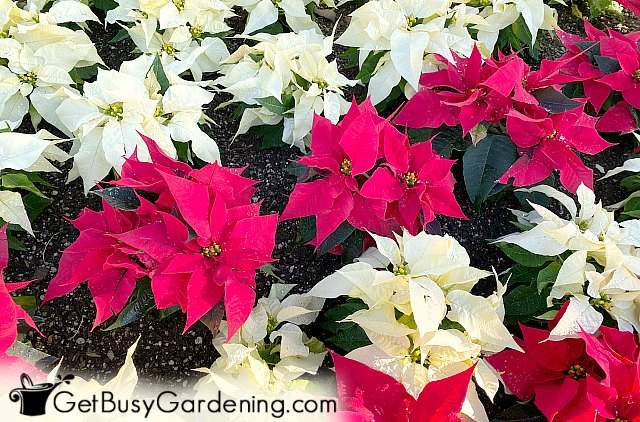
Soil Requirements
They aren’t picky about the quality of soil, so you don’t need to buy anything fancy. However, you should always grow them in a fast-draining mix.
You certainly could use a standard potting mix if you prefer. Just add some perlite, coarse sand, or pumice into the mix to help improve drainage.
Repotting
The best time to repot poinsettias is in the spring or early summer, and doing so will help to trigger fresh new growth.
Some people repot them yearly as part of the process of making them rebloom. While this certainly is not required, it’s something that you can try if you haven’t been successful with getting them to turn red.
Just be sure to always use a container that has holes in the bottom to allow for adequate drainage. You can always drop it into a decorative cache pot to dress it up.
Fertilizing
It’s important to fertilize as a part of your regular poinsettia care routine in order to keep them healthy for the long term. Start feeding in the spring, and continue until fall.
Feed them every-other-week with liquid fertilizer or compost tea (which you can get as either a concentrate or tea bags).
Or add slow release fertilizer to the soil in the spring, and a couple of times throughout the summer.
Stop in October/November timeframe, and do not fertilize them while they’re blooming.
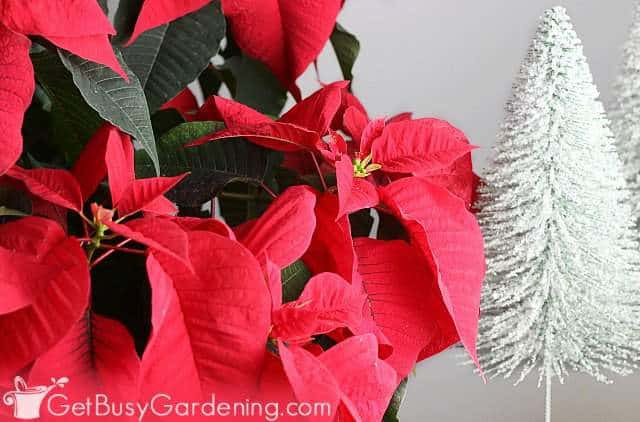
Temperature
As I mentioned above, poinsettias cannot tolerate cold weather. So when you purchase them in the winter, make sure that you wrap each one well before transporting them out to your car.
Once you bring them home, keep the temperature between 60-80°F. They also do best when it’s slightly cooler (10-15°F) at night than it is during the day.
For best results, do not place them where they will encounter gusts of cold air, such as an exterior door or drafty window.
Also be sure to keep them away from heat sources, like fireplaces, radiators, or vents.
Pruning
Pruning is an important part of long-term poinsettia care. They tend to get tall and sparse with age, and regular trimming will keep them full and bushy.
Cut back the stems in the spring to encourage branching and lots of new foliage. Use a sterile and sharp pruning shears, and be sure to wear gloves and eye protection to prevent exposure to the sap.
Disease Issues
There are a few diseases that commonly infect poinsettia plants, and can cause major problems. Spot anthracnose is a fungus that causes white lesions to form on the stems.
Another fungal disease that infect them is powdery mildew. Although not likely to kill your plant, it can negatively affect the appearance.
The best way to prevent both of these is to water at the root zone, instead of over the top of the foliage. Also, be sure they’re not overcrowded, and each one gets plenty of airflow.
Pest Control
For the most part, poinsettias don’t have many problems with insect pests, but they are sometimes susceptible to spider mites and whiteflies.
Both of these pests feed on the leaves. But before you begin treatments, it’s best not to spray anything on the foliage.
So, if you do find bugs, you can wipe both the tops and bottoms of the leaves with a damp cloth soaked in a neem oil solution or an insecticidal soap.
You could also try washing them with diluted mild liquid soap (1 teaspoon per liter of water) and rinse them well. But be sure to test these on a few leaves first to prevent damage.
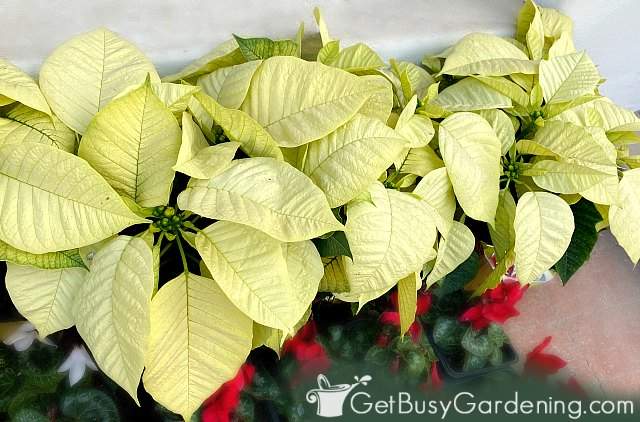
Poinsettia Propagation Tips
The easiest way to propagate poinsettias is to take cuttings from a mature plant. Make sure they are 4-5″ long with a few leaf nodes on them.
Remove the lower leaves, and allow them to cure until the wounds callus over. Then dip the cut end into rooting hormone, and place them into a sandy soil mix.
You could also grow them from seed, which is actually fairly easy. However, it will take a very long time to get a substantial plant. But it would be fun to experiment!
Troubleshooting Poinsettia Care Problems
The most difficult part of poinsettia care is when your plant starts to have problems, and you have no idea what’s wrong. So below I’ve listed some of the most common ones, with tips for fixing them.
Leaves Are Falling Off
Leaf drop is commonly caused by sudden temperature shifts or improper watering (either too much or too little).
Check the soil to make sure it’s not wet or bone-dry, then ensure they aren’t being exposed to hot or cold drafts.
However, keep in mind that this is also a part of their natural lifecycle. It’s normal for the leaves to start dropping after they’re done blooming, and they begin their rest period.
Drooping Leaves
Droopy leaves are also caused by over or under watering or exposure to extreme hot or cold drafts.
Check the temperature of the location, and water only when the top inch of soil is dry.
White Spots
Most of the time, white spots on the leaves are from water droplets. But it could also be caused by disease.
To avoid this, water at the base of the plant, improve the air circulation, don’t mist it, and keep the foliage dry at all times.
Yellow Leaves
Yellowing is almost always caused by overwatering. Allow the soil to dry out more in between, and use a moisture gauge to get it right.
Also ensure the pot has adequate drainage holes, and never leave it soaking in a full drip tray.
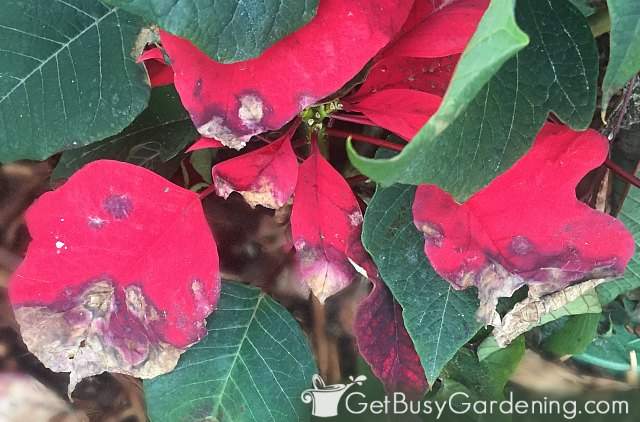
Poinsettia Plant Care FAQs
In this section, I will answer some of the most frequently asked questions about poinsettia care. If you don’t find yours here, then ask it in the comments below.
Do poinsettias come back every year?
Yes, poinsettias come back every year in their native habitat. But you’ll need to keep them indoors during the winter unless you live in a very warm climate (zone 10 or higher).
Can you keep a poinsettia year round?
Yes, you can keep a poinsettia year round, and they aren’t that difficult to care for once you know what they require.
How long can you keep a poinsettia alive?
You can keep a poinsettia alive for many years. They are perennials in zones 10 or higher, but can also do well as a houseplant.
How long do poinsettias last?
Poinsettias tend to last about 2-3 months after the holidays, with the proper care. However, they can live for many years, if you’re up for the challenge.
Where do poinsettias grow best?
Poinsettias grow best in an area where they will receive bright, indirect sunlight and the temperature stays between 60-80°F.
Poinsettia care isn’t difficult once you know how. So, after incorporating them into your holiday decor, be sure to keep yours growing so you can enjoy it year after year.
If you want to learn all there is to know about maintaining healthy indoor plants, then you need my Houseplant Care eBook. It will show you everything you need to know about how to keep every plant in your home thriving. Download your copy now!
More Holiday Plant Care Guides
- How To Care For Holiday Cactus
- How To Care For A Thanksgiving Cactus Plant (Schlumbergera truncata)
- How To Care For An Amaryllis
- How To Take Care Of A Cyclamen Plant
- Christmas, Thanksgiving, & Easter Cactus: How To Tell Them Apart
- How To Care For An Easter Cactus Plant (Schlumbergera gaertneri)
Share your best poinsettia care tips in the comments section below.
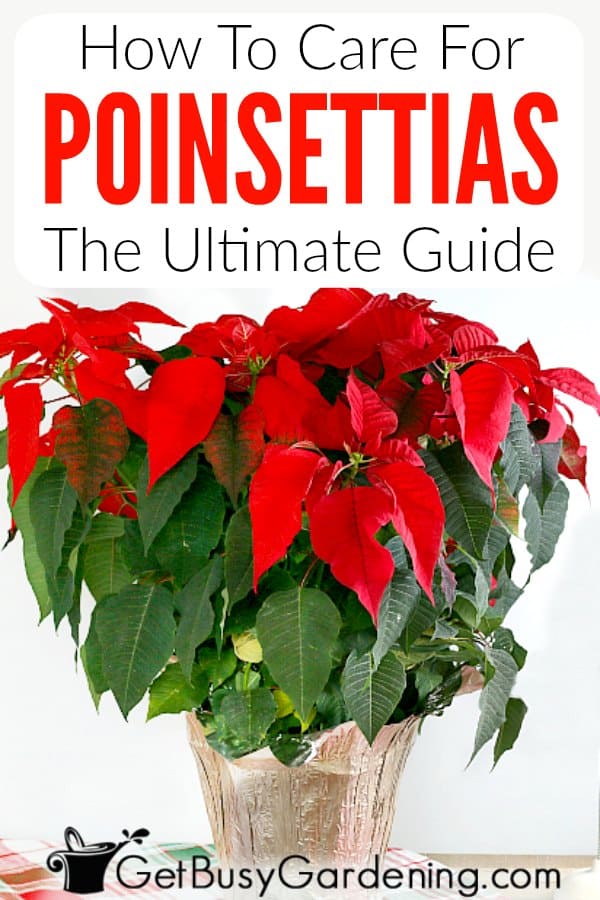
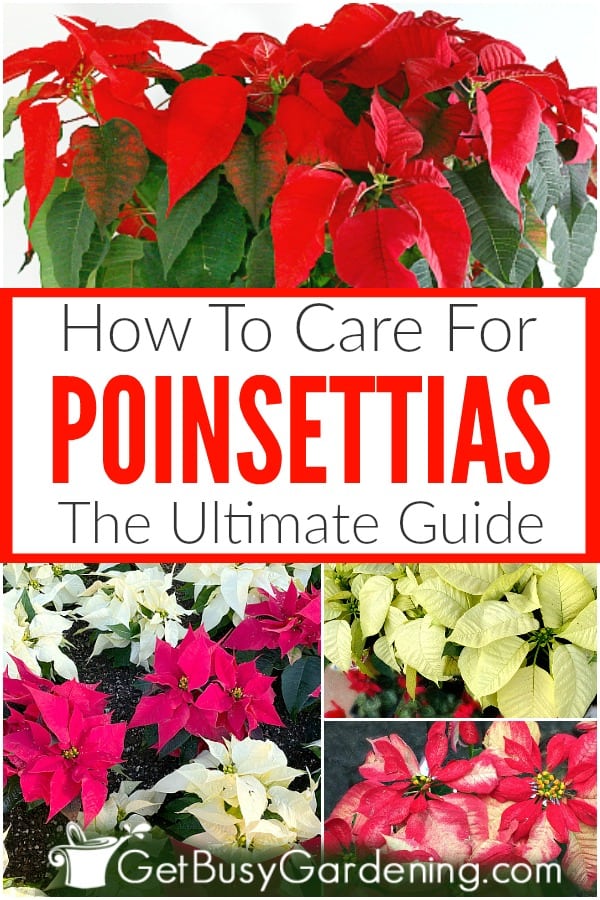

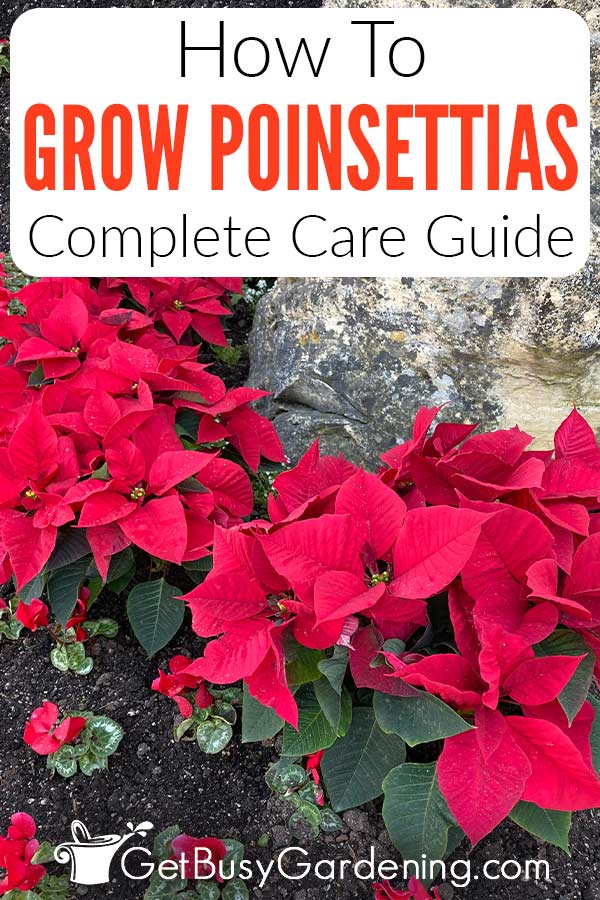





Judy Christensen says
Hi Amy
You mentioned trimming the plant when it starts getting leggy. How much do you recommend to trim back?
As always you have great information to give us.
Thanks
Judy
Amy Andrychowicz says
You can cut your poinsettia back by up to 1/3 of it’s current size, but wait until spring to do it.
Astridah Musukuma says
Thanks for this great information of helping the Christmas plant bloom was wondering why mine doesn’t give me a red color it’s always healthy and green. Thanks again for this educative information will keep it dark for the recommended hours from the author so that l can see the precious red flowers
Amy Andrychowicz says
You’re welcome! I hope you’ll be able to successfully turn your poinsettia red again with these tips. Good luck!
Kim says
I purchased the flower in December . It is now January. Is it normal for the leaves and flowers to start dropping and basically going to just the stems???
I am keeping them indoors and just in the plastic drainage pot they came in . I just would like to better u dee stand the plant it not dead because I am wanting for it to bloom again later this year .
What do you recommend and is it normal flowers and leaves are falling off in January?
Amy Andrychowicz says
Yes, it is normal for poinsettia leaves to start dropping after they’re done blooming. This is the first sign that they’re starting their rest period. However, leaf drop can also be caused by improper watering, so make sure you are not over or under watering it.
Martha Norman says
Thanks for the tips! I was given a winter-white 6″ poinsettia for Christmas. It’s from Home Depot, in a lovely decorative silver pot. The inside plant-pot (which the poinsettia is in), of course, has a hole in the bottom for drainage. When you lift the inside pot up, there is water on the bottom (about 1/3″) of the outside pot. The decorative mylar foil surrounds the inside pot but appropriately does not cover the bottom to keep the drainage hole uncovered. At some point, maybe mid-late January, I will want to remove the poinsettia (keeping it in its ”inside pot”) from the outside pot and set it on a plastic ridged circular 1″ plant tray, as I do not think it is wise to keep the plant inside the decorative outer pot for weeks on end. Do you agree with my idea of discarding the outside pot and having the plant set on a circular ridged 1″ tray?
Amy Andrychowicz says
Yes, that would work just fine. Those foil covers are just cheap temporary holders anyway, and it sounds like yours is inhibiting proper drainage. Your poinsettia would be much happier sitting on a tray that allows the water to drain freely.